The second leg of the first Coppa Italia semi-final saw Juventus host Milan at the Allianz Stadium on 12 June 2020. The game was setup beautifully after the first leg ended square at 1-1 at the San Siro. Milan, with that draw, broke a streak of 9 consecutive defeats against Juventus. Milan had twice as many shots and on-target shots as Juventus, despite having less of the ball. But an unfortunate penalty conceded in injury time saw Cristiano Ronaldo equalise for Juventus. This tactical analysis is on the second leg of the Coppa Italia semi-finals.
The second leg at the Allianz Stadium began rather unceremoniously for the visitors. Milan conceded a penalty in the 13th minute, which Cristiano Ronaldo failed to convert (!). Six seconds later, Ante Rebić was sent off for a kung-fu tackle on Danilo. From then on, Milan held their defensive shape to frustrate the hosts. The game ended 0-0 and 13 time winners Juventus, progressed to the final of the Coppa Italia where they will play Napoli.
Given that Milan were missing key players due to suspension, and were down to ten men within the first 15 minutes, it would be fair to say that they won the game with the 0-0 draw. However, Juventus won the tie and progressed on the away goals rule after drawing 1-1 at the San Siro. This tactical analysis aims to study the tactics deployed by both the teams and how the game unfolded. The analysis is solely based on this game, and all the data and image references used are courtesy Wyscout.
Line-up
In a tweak of tactics, Maurizio Sarri setup his Juventus side in a 4-3-3. They’ve only used this formation 16% of the time, and have favoured a 4-3-1-2 the most (61%). Gianluigi Buffon started in goal with Alex Sandro, Matthijs De Ligt, Leonardo Bonucci & Danilo as the back four. Rodrigo Bentancur, Blaise Matuidi and the under-fire Miralem Pjanić started in midfield behind a front three of Cristiano Ronaldo, Douglas Costa & Paulo Dybala.
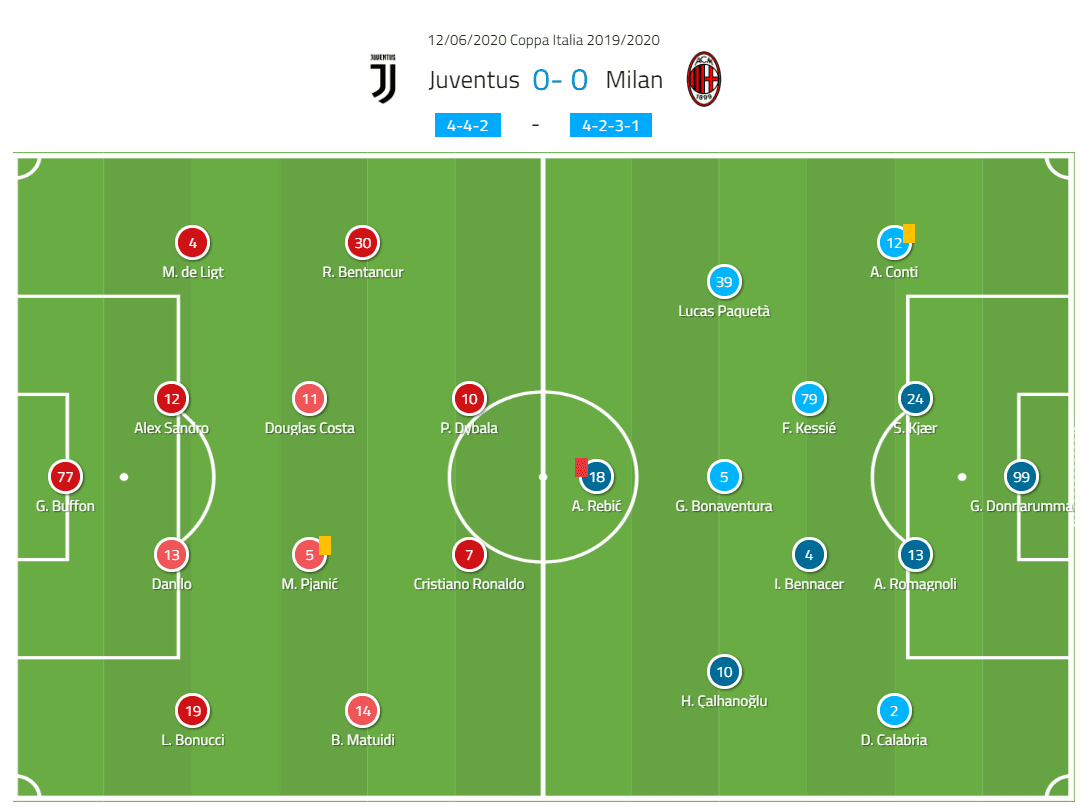
Stefano Pioli also altered tactics by setting his team up in a 4-2-3-1. Milan have used a host of formations this season including a 4-3-3 (23%) and a 4-1-4-1 (22%), both more often that the 4-2-3-1 (17%). Gianluigi Donnarumma started in goal with Andrea Conti, Simon Kjær, Alessio Romagnoli and Davide Calabria as the back four. Franck Kessié and Ismaël Bennacer played as the midfield pairing. Lucas Paquetá, Giacomo Bonaventura and Hakan Çalhanoğlu played the three behind sole striker Ante Rebić. Milan had to make do without three key players who were out with suspension – Theo Hernández, Zlatan Ibrahimović (+injury) and Samuel Castillejo.
Juventus’ Smart Press
Juventus played with a front three of Ronaldo, Dybala and Costa. While the usual high press would involve the three forwards pressing against the opposition defence, Juventus switched tactics up a bit. The tactical analysis highlights how a fourth player constantly came up from the midfield to press the opposition defence, along with the front three. This way, Juventus would close down Milan’s multiple passing options with a sense of urgency, and force them to pass the ball to the only path they’ve left deliberately open. By making the next pass predictable, they were able to do two things:
a. Force the play into a direction they want to,
b. and isolate sections of the pitch to frustrate the opposition
Below are some instances of both of the above points. The first is from early on in the game when Bentancur pushes forward to press Romagnoli. The analysis shows that when Bentancur starts moving forward, he blocks the pass passage between Romagnoli and Bennacer. Simultaneously, Ronaldo blocks the passage between Romagnoli and Kessié. As Bentancur moves towards Romagnoli, he forces the Milan captain to make a quick choice for a way out. The way out comes in the form of a clear passage between himself and Calabria, which he goes for straight away and passes the ball. However, this passage of play is only seemingly free. It has been deliberately left open so that the play is directed towards that part of the pitch. In this case, for two reasons: First, to direct play towards a non-regular left-back Calabria who is only filling in for the suspended regular Theo Hernández. Since Calabria is new to the position, he may be easier to deal with. Second, to isolate the midfield from the defence and push the ball out wide. By doing this, they can also isolate the attacking threat of Milan who are deprived of all service. The below images depict the said tactics and the effect of the tactics.
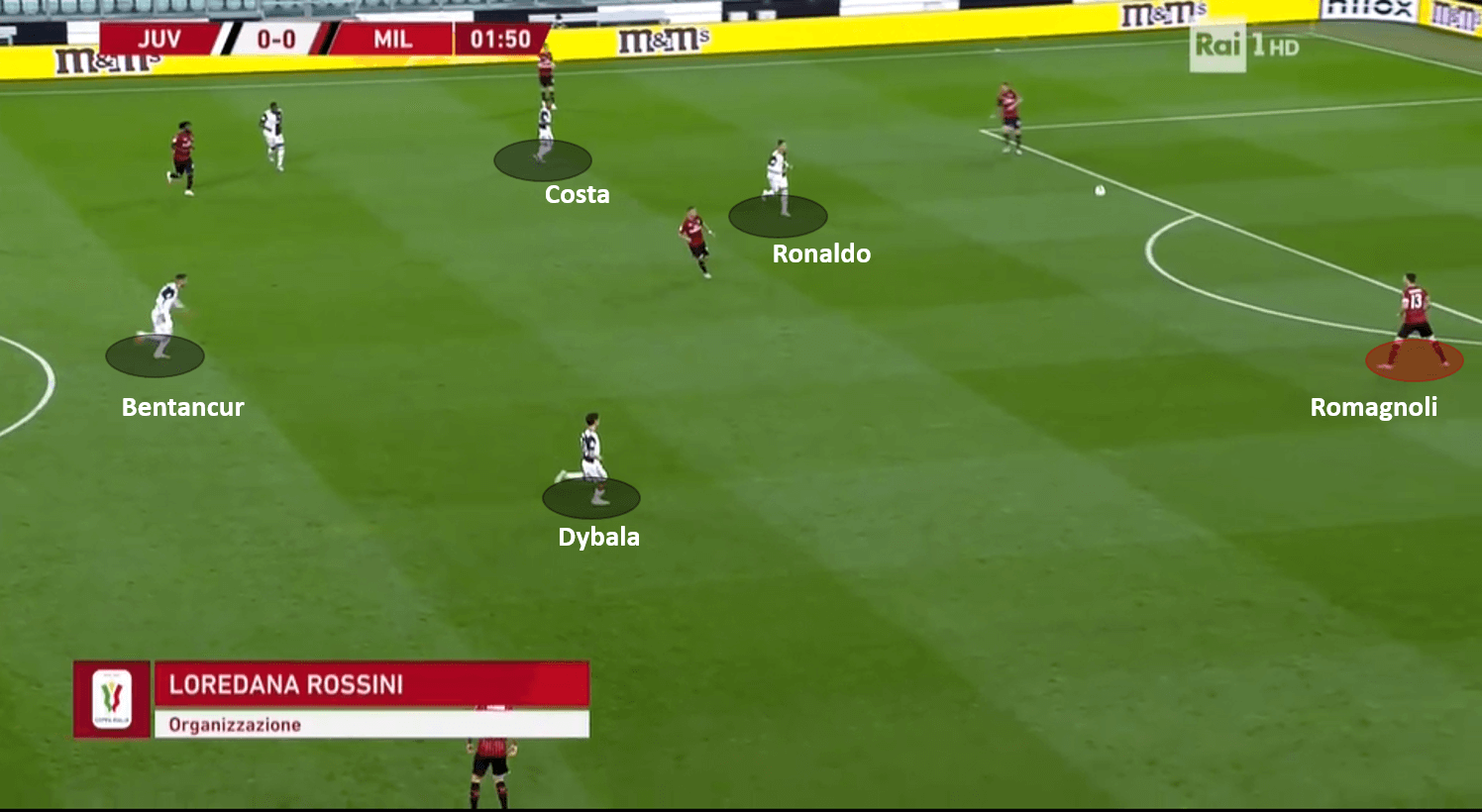
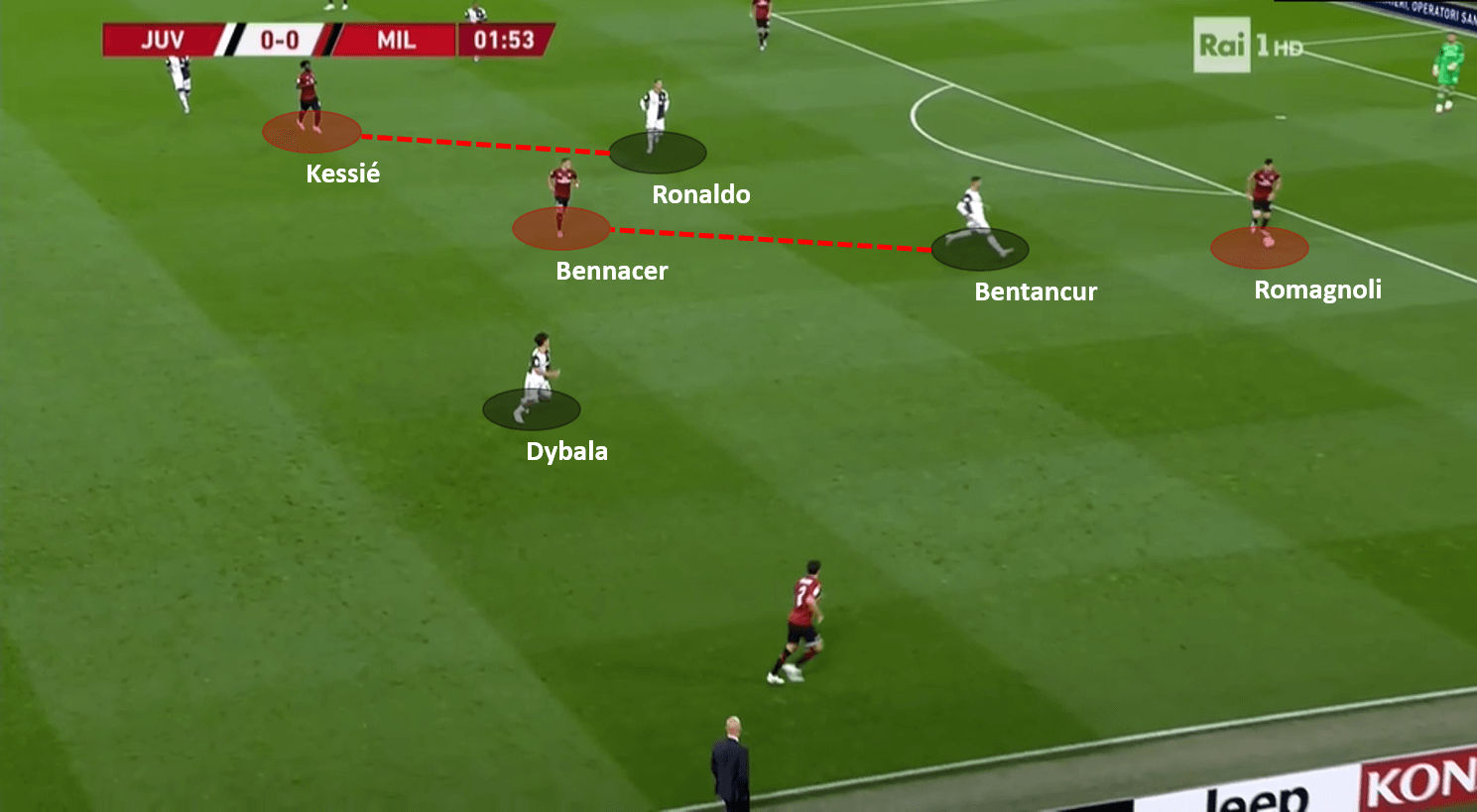
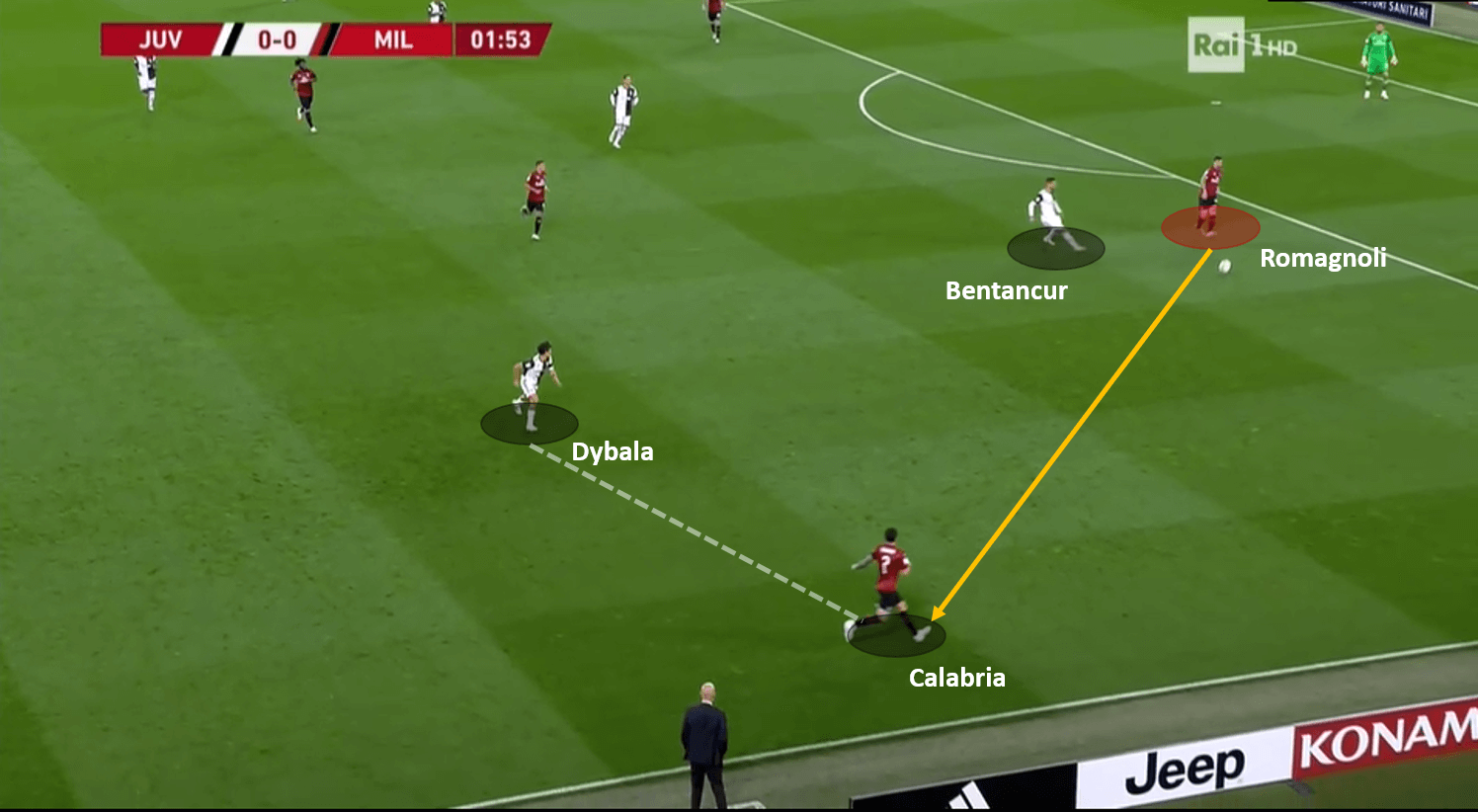
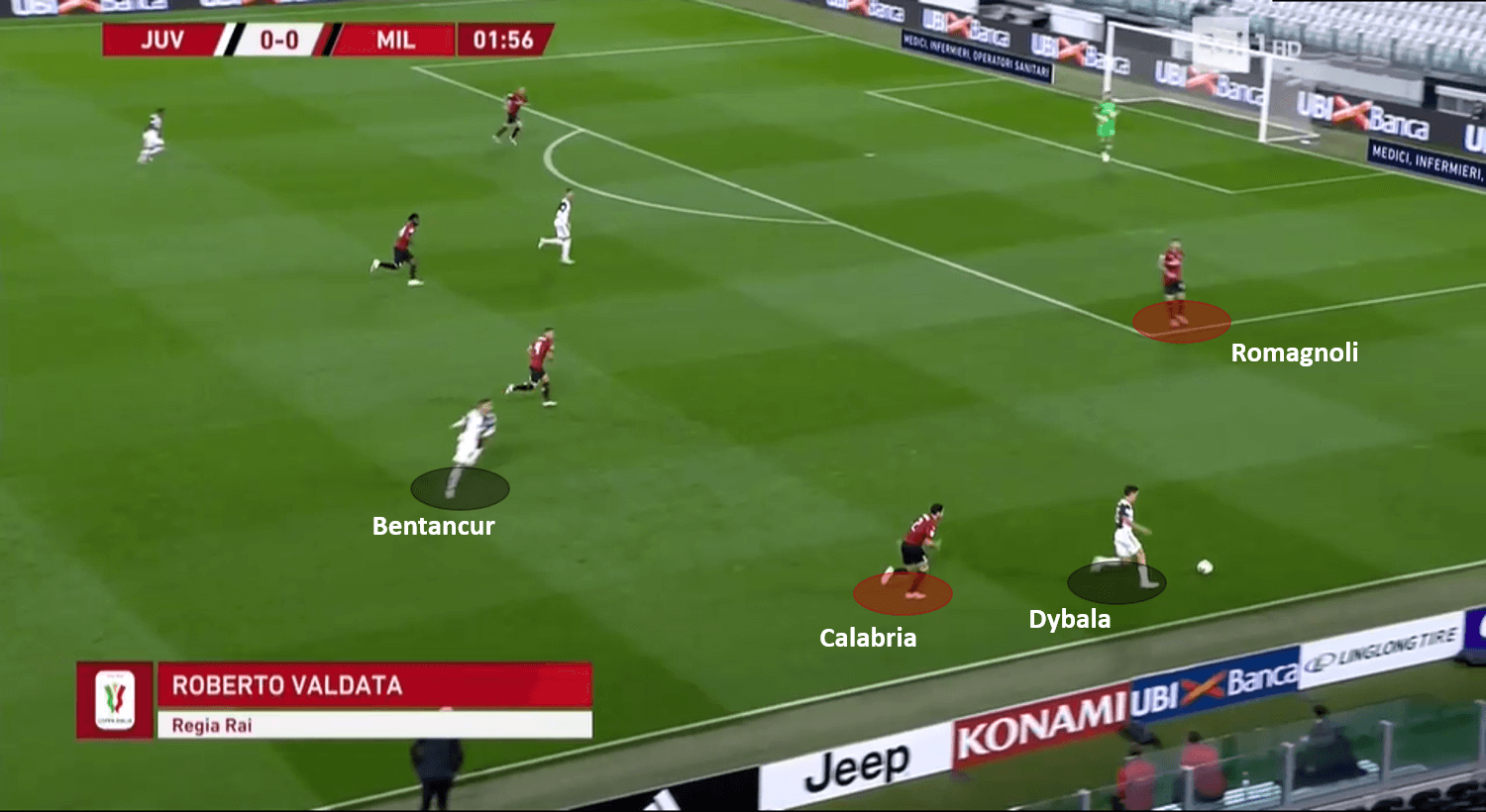
Juventus’ constant dictation of the play passages and control of play played a major role in frustrating the isolated Ante Rebić. Below is one such play which frustrated Rebić.
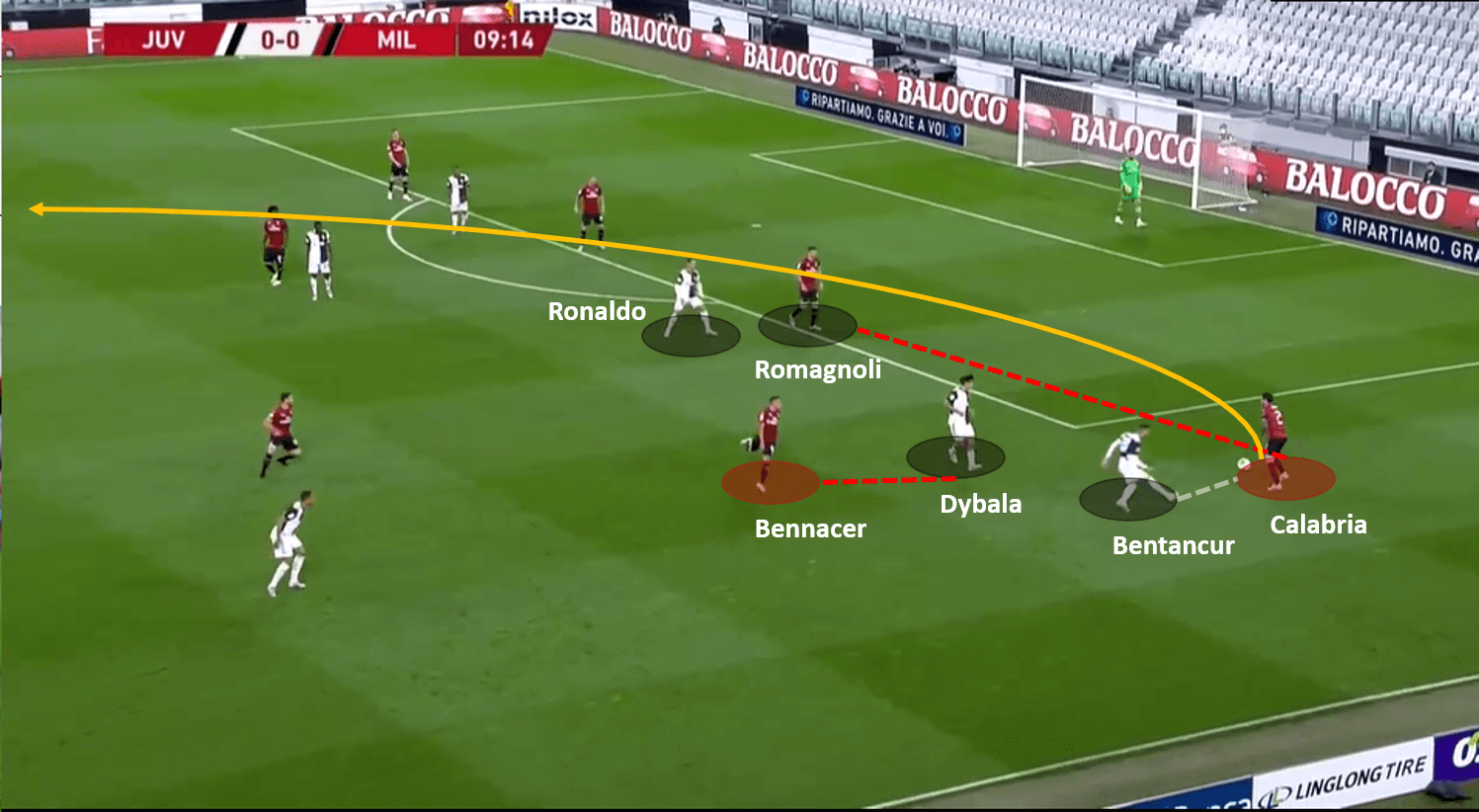
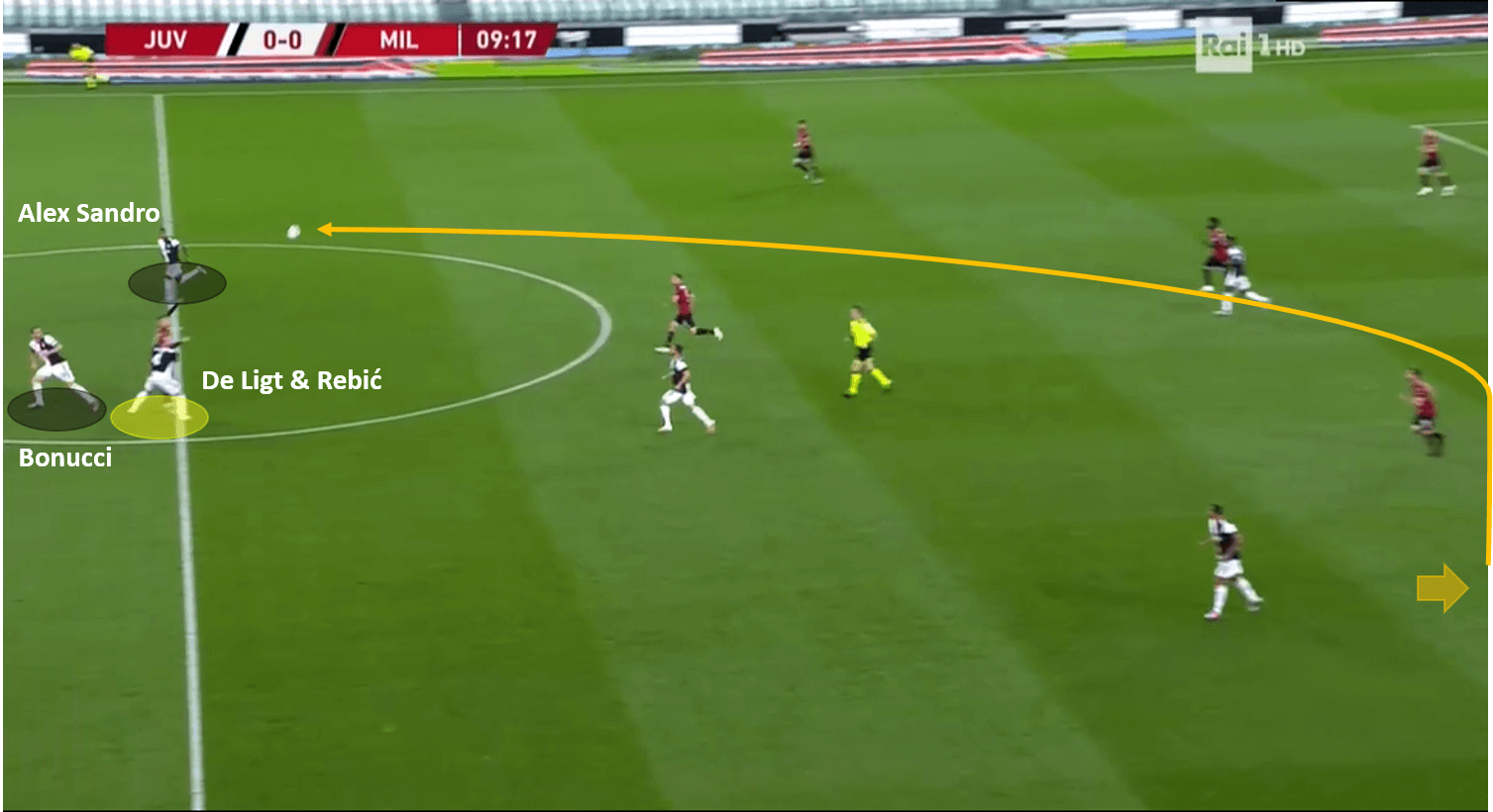
Another such play, and four minutes later, Rebić makes a horror reach for the ball and ends up catching Danilo. His desperate reach to get a touch of the ball ended up in an early shower.
Milan’s solid shape
The tactical analysis shows that the high intensity closing down adopted by Juve, and their smart pressing enabled them to isolate the Milan team into pockets. The most affected by this forced isolation, Ante Rebić. A stellar passage of play by Juventus in the beginning few minutes saw Rebić isolated at the far end with three Juventus defenders around at all times. The Milan players were not able to move the ball forward into the attacking third, which meant that Rebić had hardly any touches of the ball until the 13th minute. Right after Milan gave away a penalty in the 13th minute, and Ronaldo surprisingly didn’t convert, Rebić received a red card for his kung-fu challenge on Danilo. Ronaldo hit the post from the penalty spot, and Calabria cleared the rebound long over Rebić’s shoulder. In a brain fade moment Rebić decided to go in with a kick near 6 feet in the air to win the ball. Hit Danilo in the chest, and earned an early shower. Just like that, Milan were down to ten men within the opening 15 minutes. You’d imagine that after this, Milan would have lost heart; au contraire, they rejigged their defensive shape and managed to keep Juventus quiet for the remainder of the 75 minutes. The below analysis tries to understand the change in shape, and how Milan managed to keep Juventus quiet.
For adding context to the analysis, below is a picture of Milan’s defensive shape before the red card. Milan defended in a standard width 4-3-3.
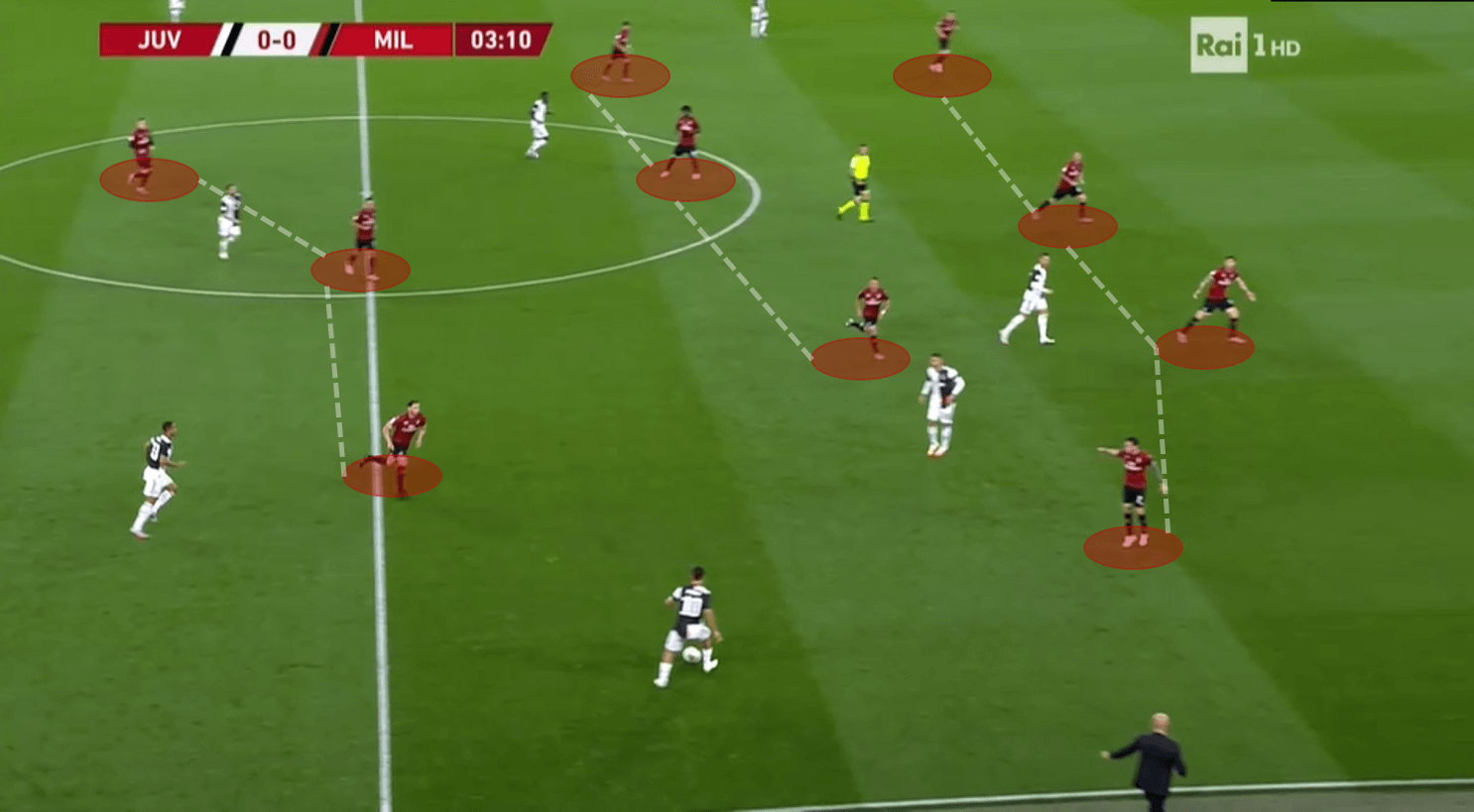
Below is an image of Milan’s defensive shape after the red card. Milan switched to a narrow 4-4-1 while defending in order to cut the passages in the middle of the field.
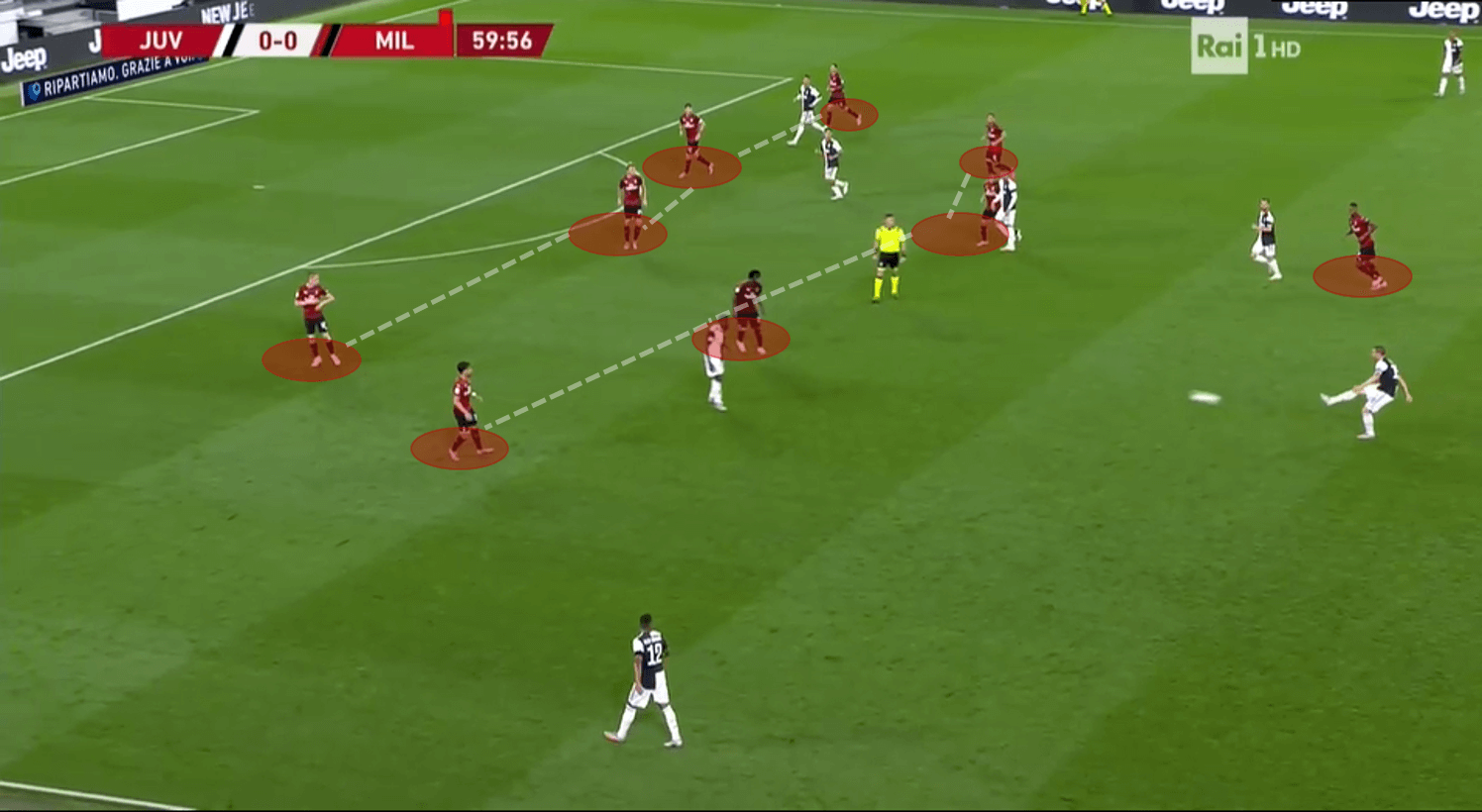
Below is another instance of the changed defensive shape.
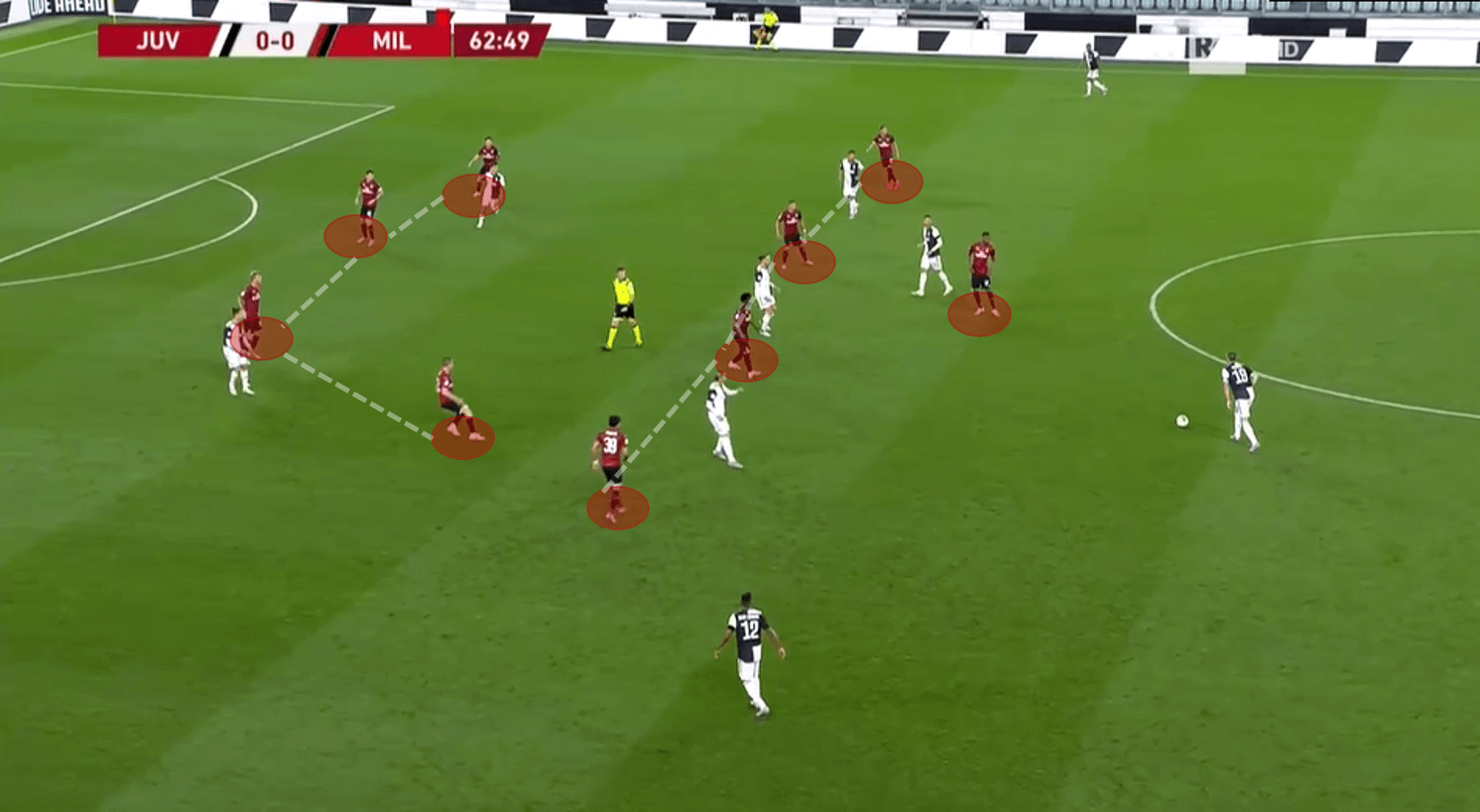
Milan showed grit and dug deep to hold the hosts at 0-0. On any other day, a 0-0 draw at the Allianz Stadium would be a win. Although Milan failed to progress to the finals on account of the away goals rule, they can take positives from the fact that they managed to keep Juventus quiet whilst playing with ten men for 75 minutes. The analysis tries to understand how the change in defensive shape and defensive tactics aided Milan in their pursuit. We have already highlighted the change in defensive shape in the paragraph above. The below analysis aims to understand how Milan executed it. Milan tried to push as many attacks as possible out wide. For this, they adopted a 4-4-1 defensive shape and setup in a narrow formation thereby limiting space in the middle of the park. Juventus had look strong coming in from the middle, Bentancur and Matuidi in particular. Even Dybala, who’d been making frequent runs in the middle to win the ball, had to be pushed out wide. While this would ensure a tight middle to play in, Milan additionally setup a man-marking system. All of Juventus’ goal scoring threats were man marked by the wide-backs, while the centre halves took care of the long balls that would come in from the attacks that were pushed out wide. This way, they ensured they covered the threat on two fronts. Below is an example of the same.
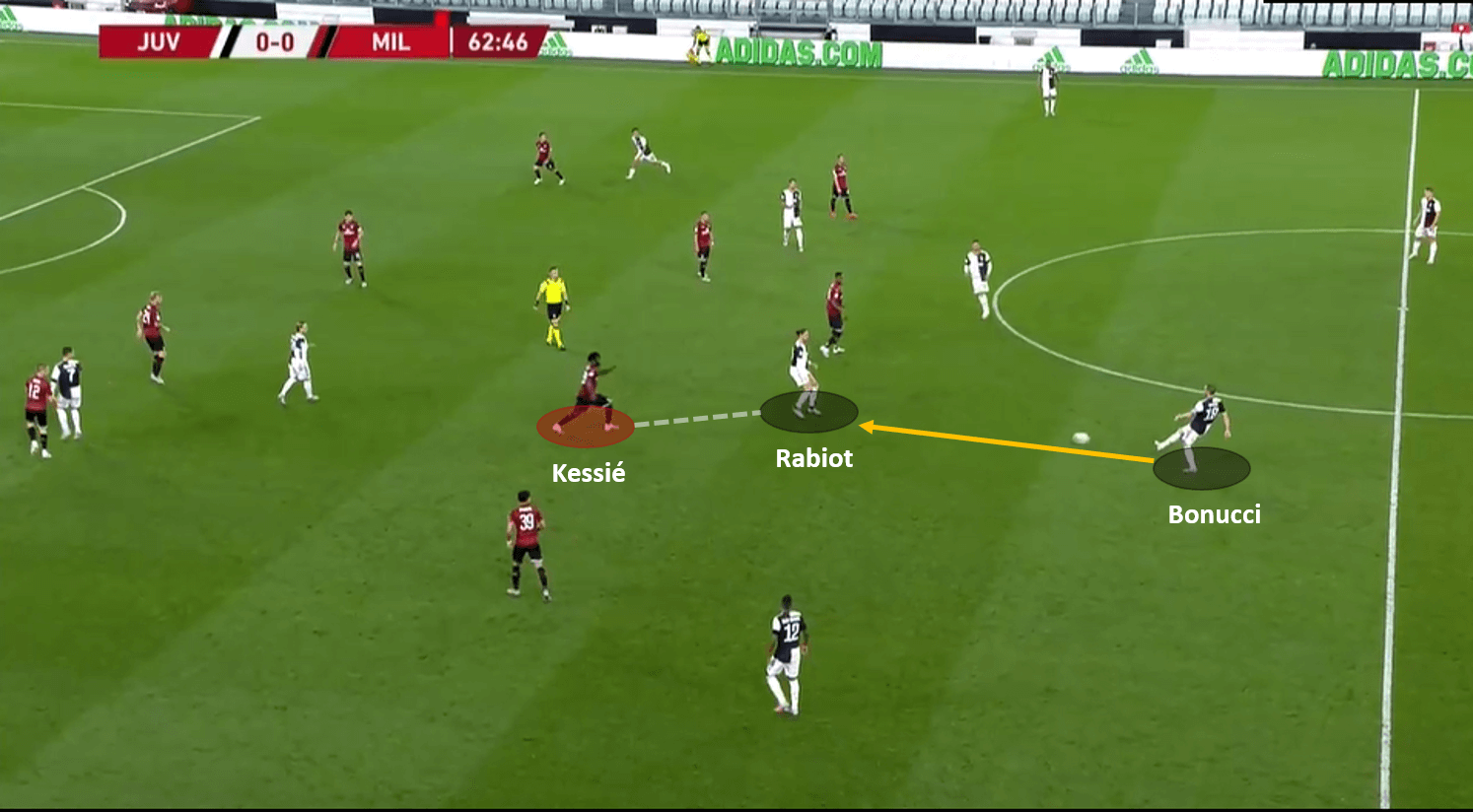
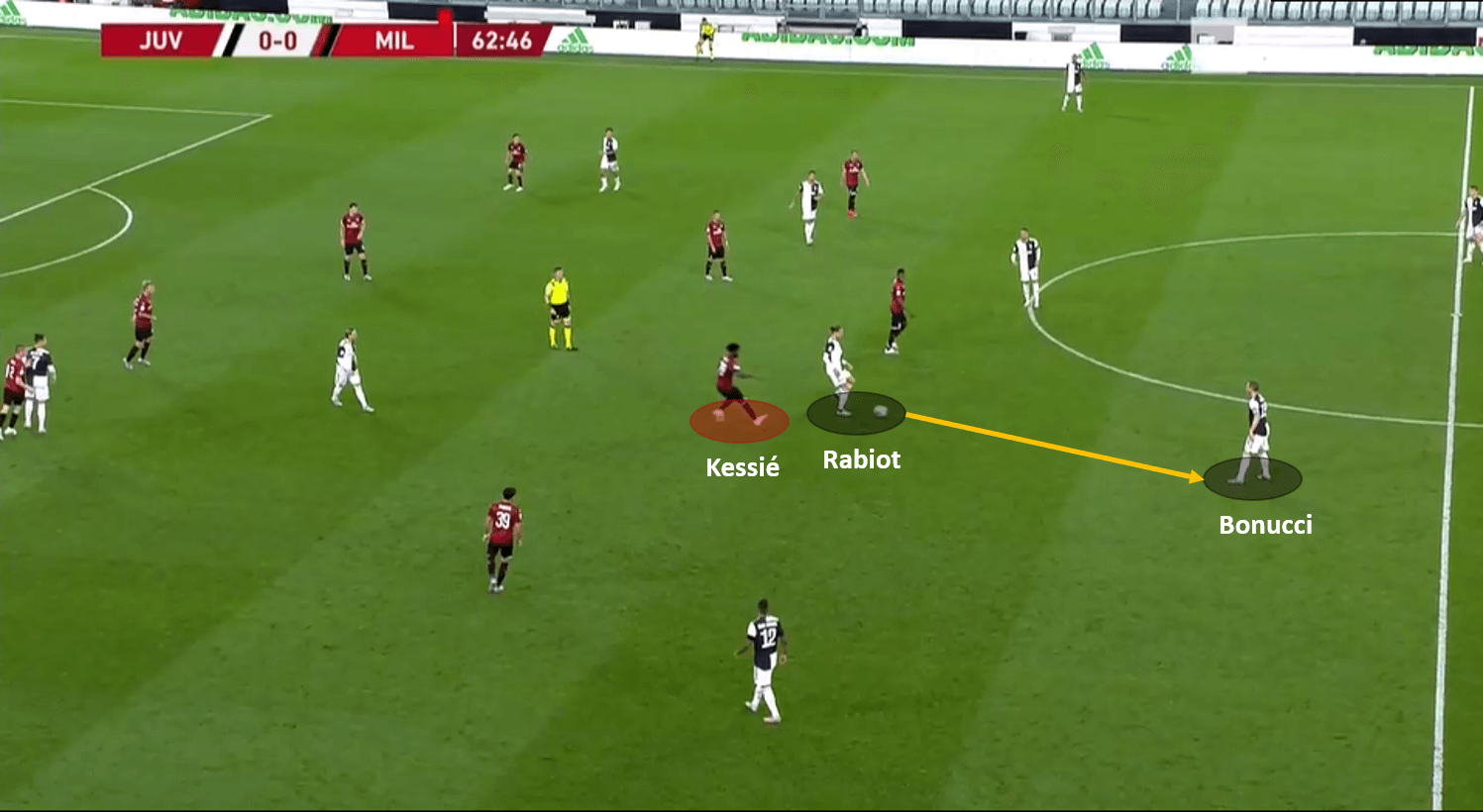
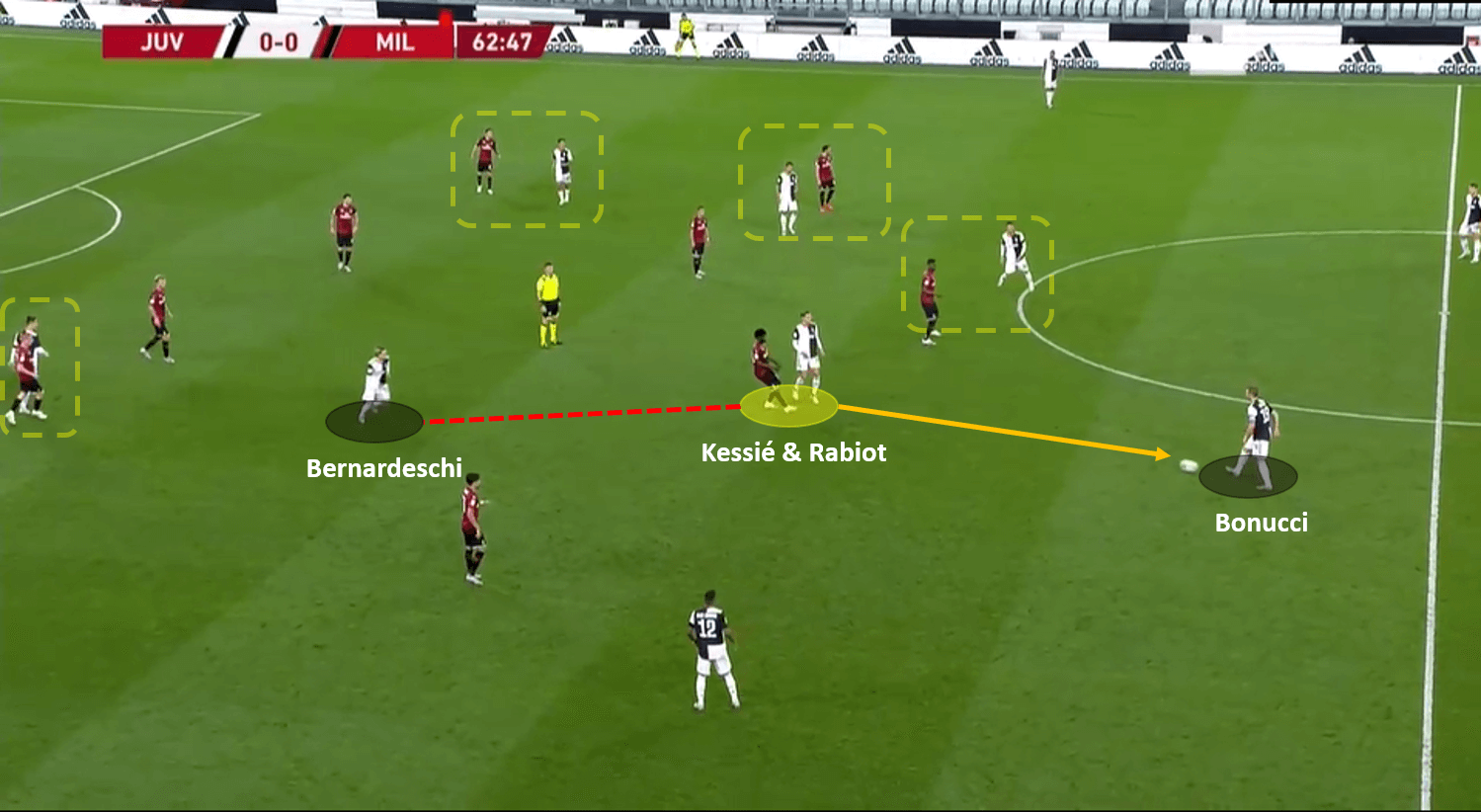
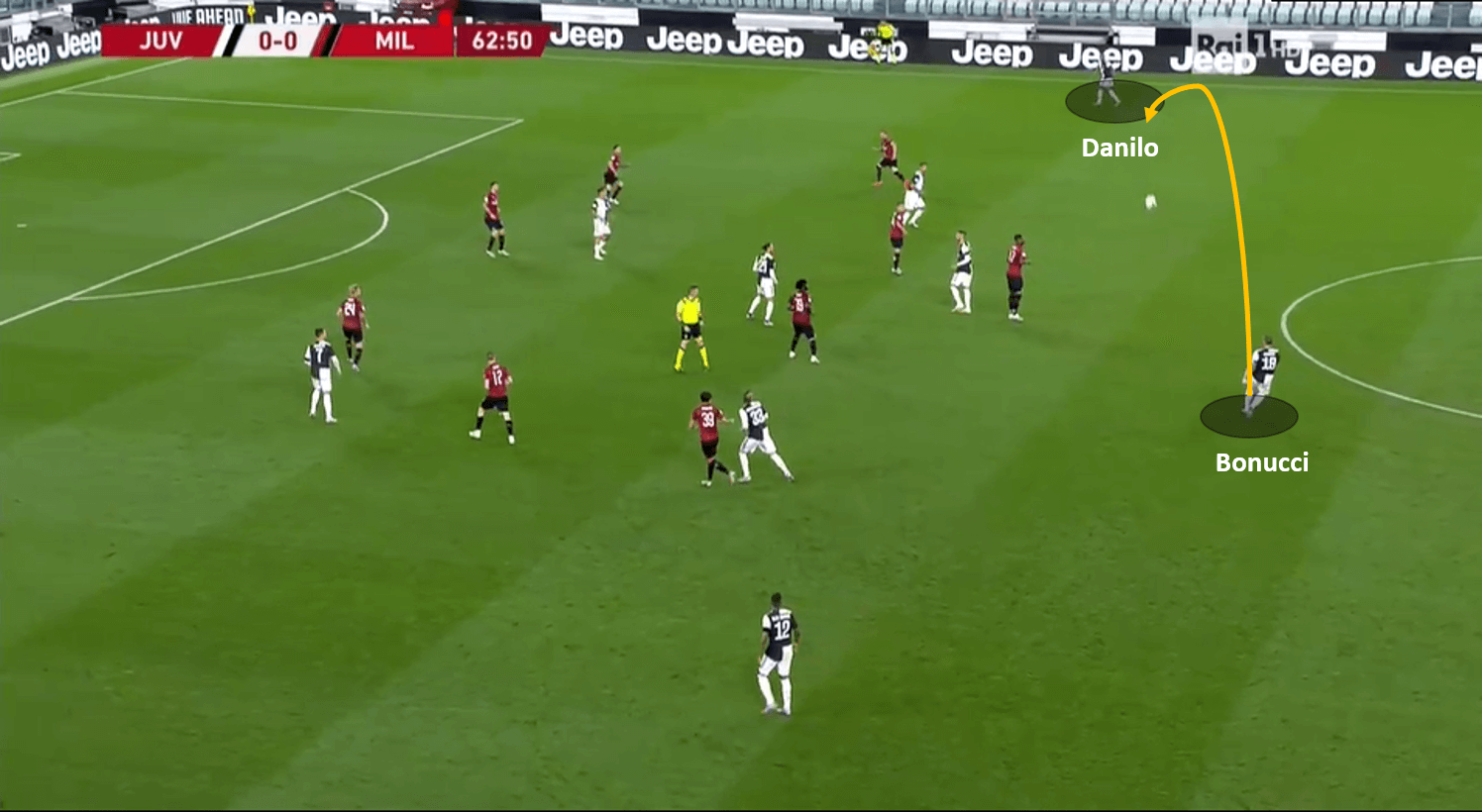
Rusty finishing all around
The first game after the restart was always expected to be high on drama and high on expectations. This game was no different, with drama right from the 13th minute – missed penalty, red card, brilliant bits of build-up play, solid defending and missed chances all around. While the game was pound for pound, it did lack the knock out blow. Both sides had a handful of chances, more Juventus than Milan, but all of them were either dealt with by the keepers or fluffed. And it isn’t just the penalty but the overall finishing that looked rusty from both sides. Below are a couple of instances, one of for each team, which really should have been taken better. It worked out well for Juventus in the end, but one might wonder what if Milan had been able to sneak one in.
Below is a quick look on how close/far Çalhanoğlu was to putting Milan ahead. Bonaventura put in a beautiful ball from the right, to a running in Çalhanoğlu. If only he connected properly with his head.
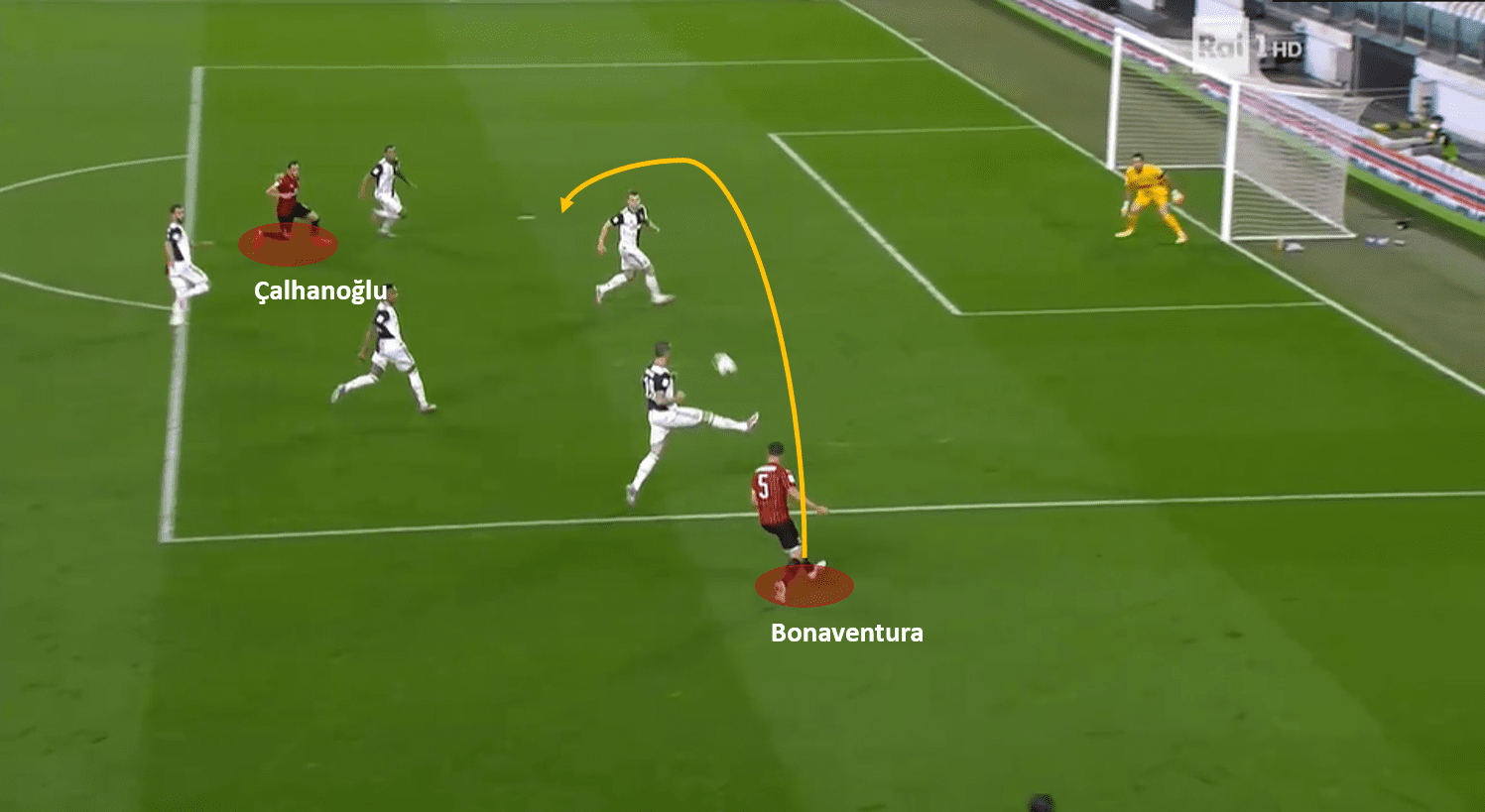
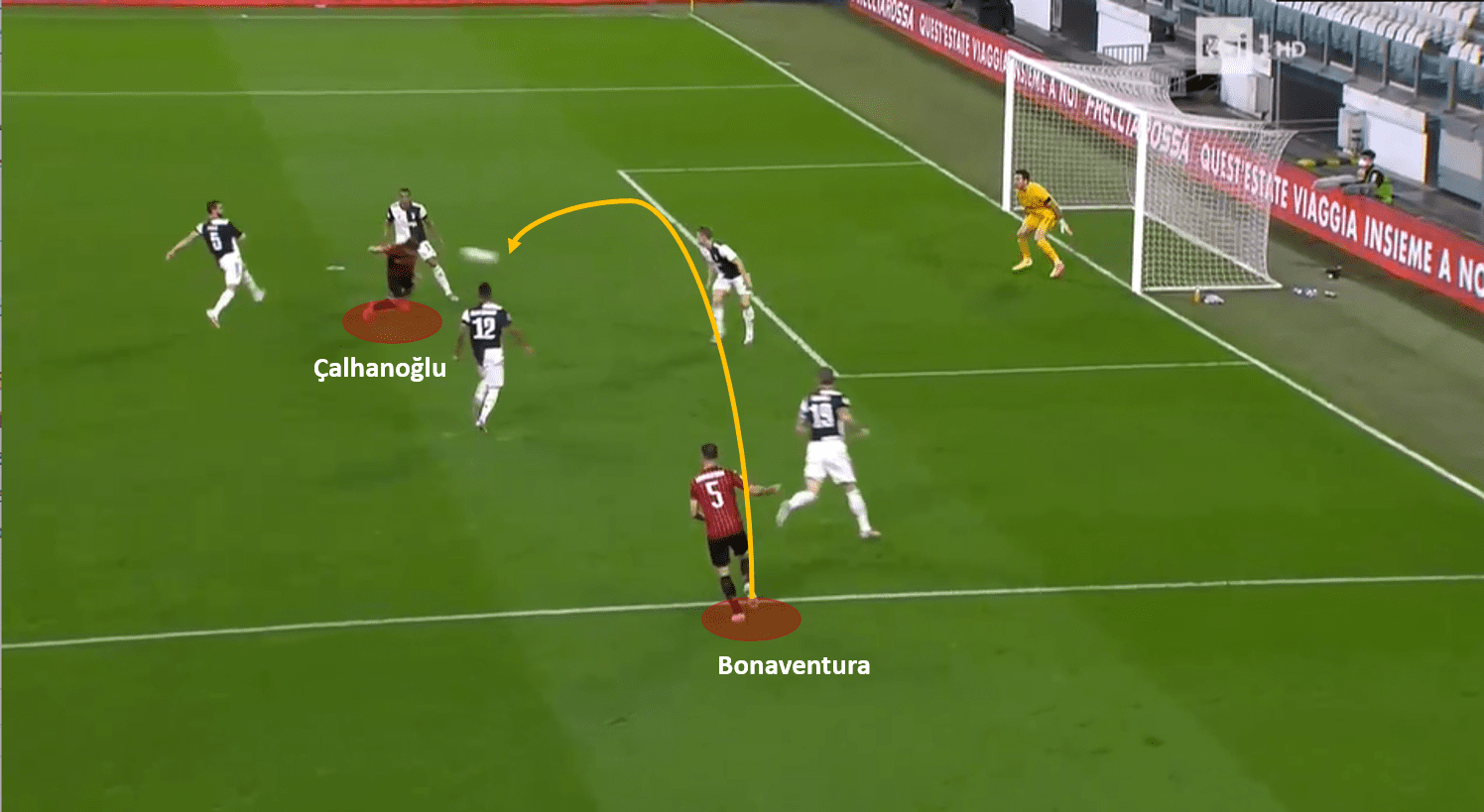
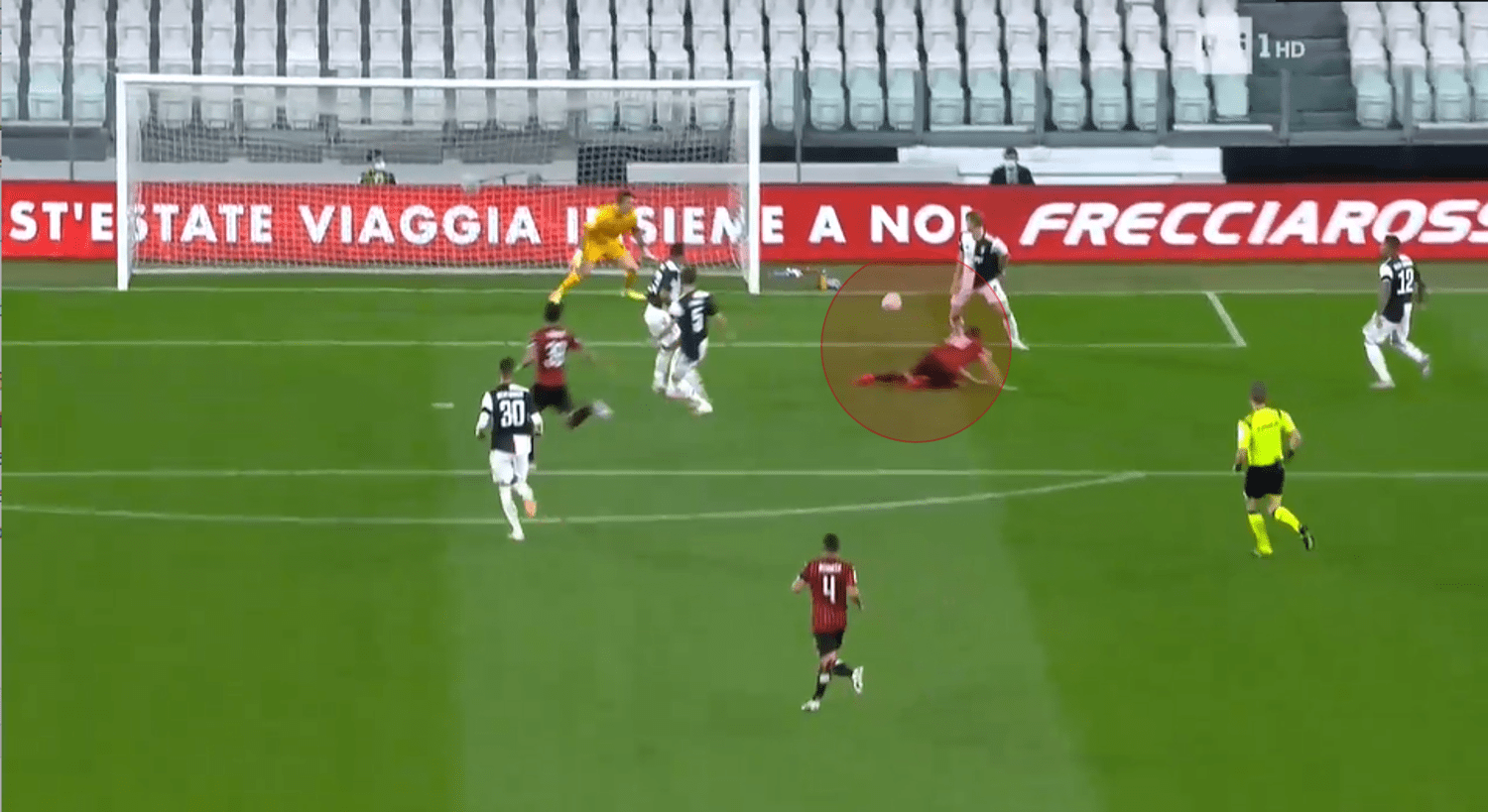
Juventus had their own share of shocking misses, setting the penalty miss aside.
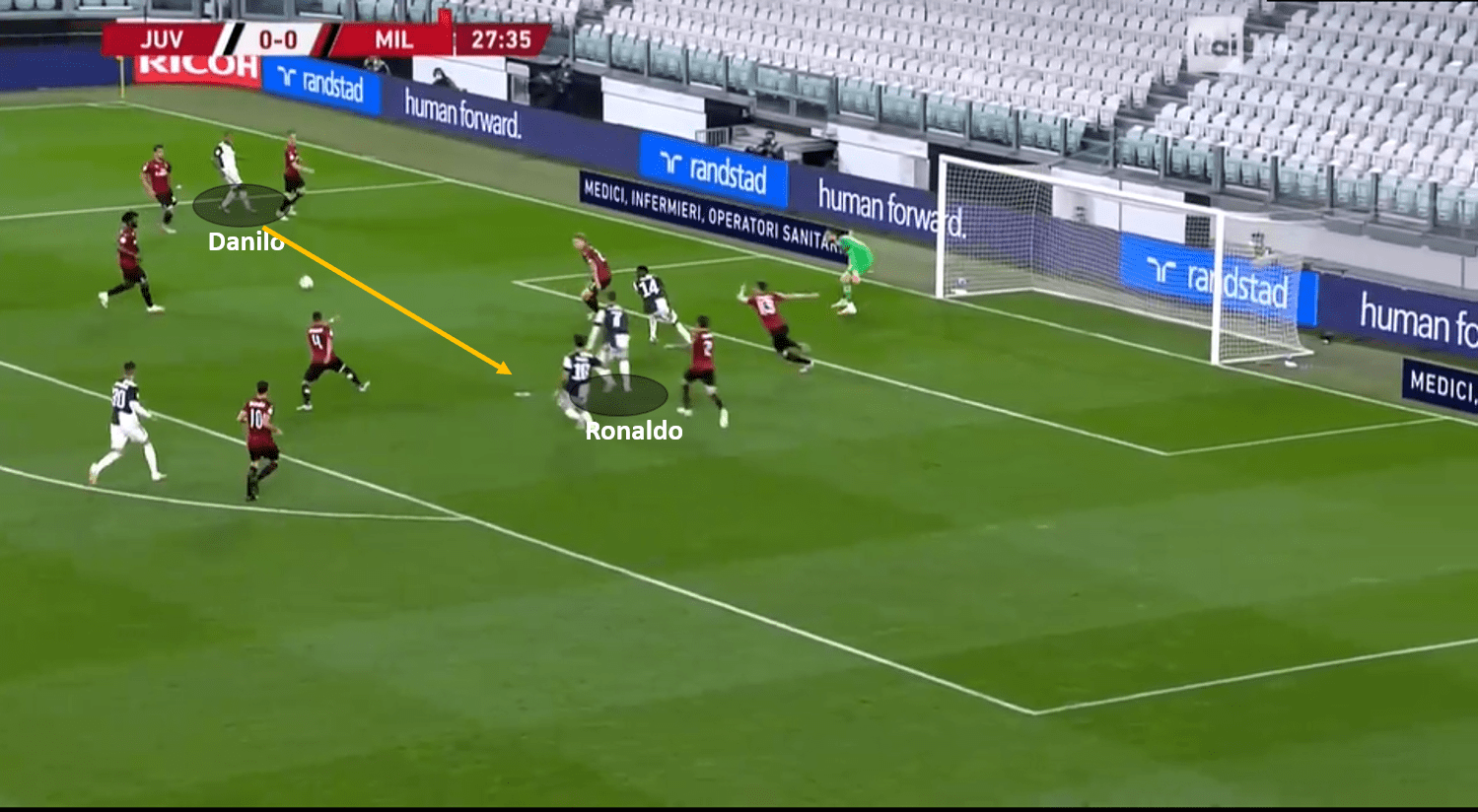
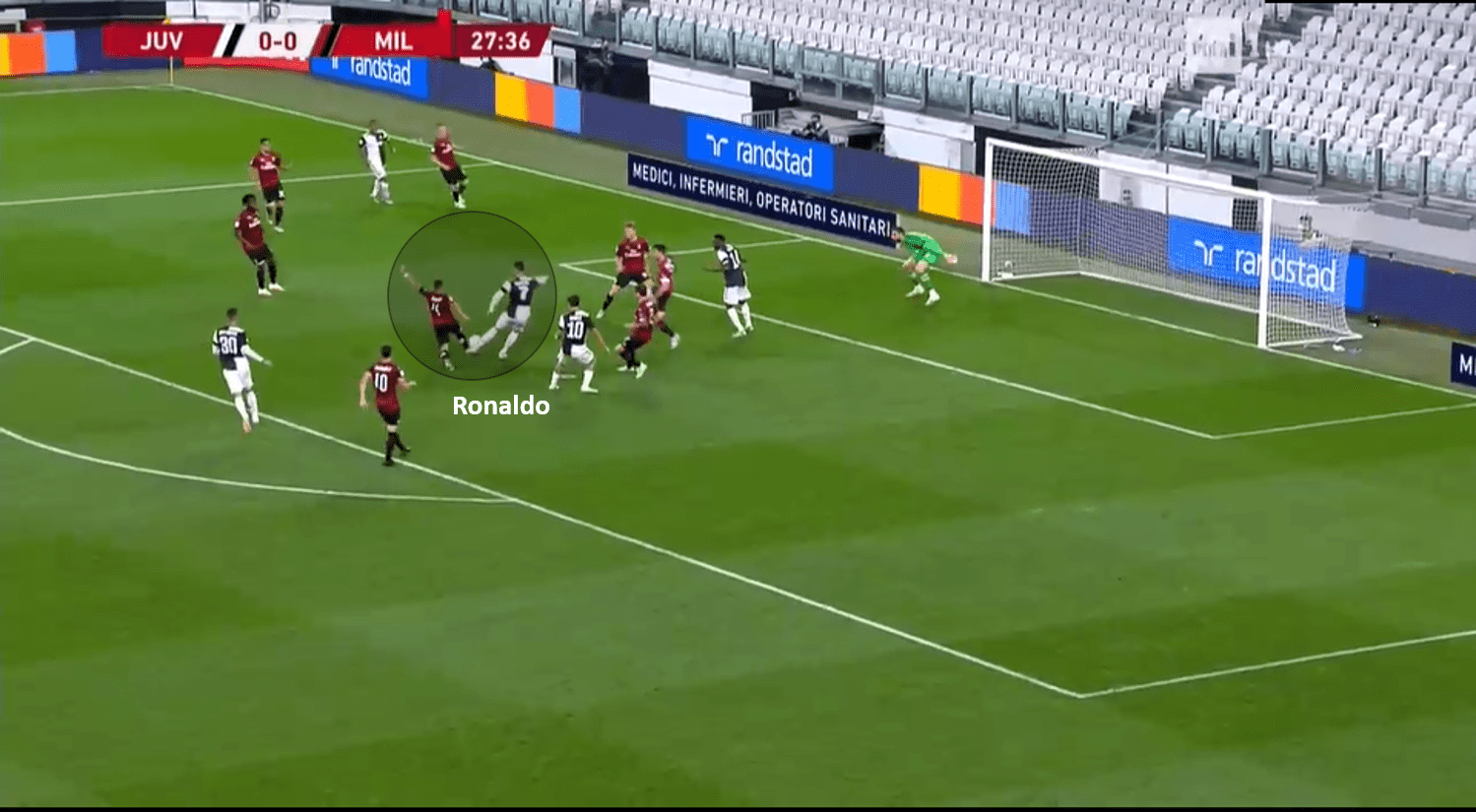
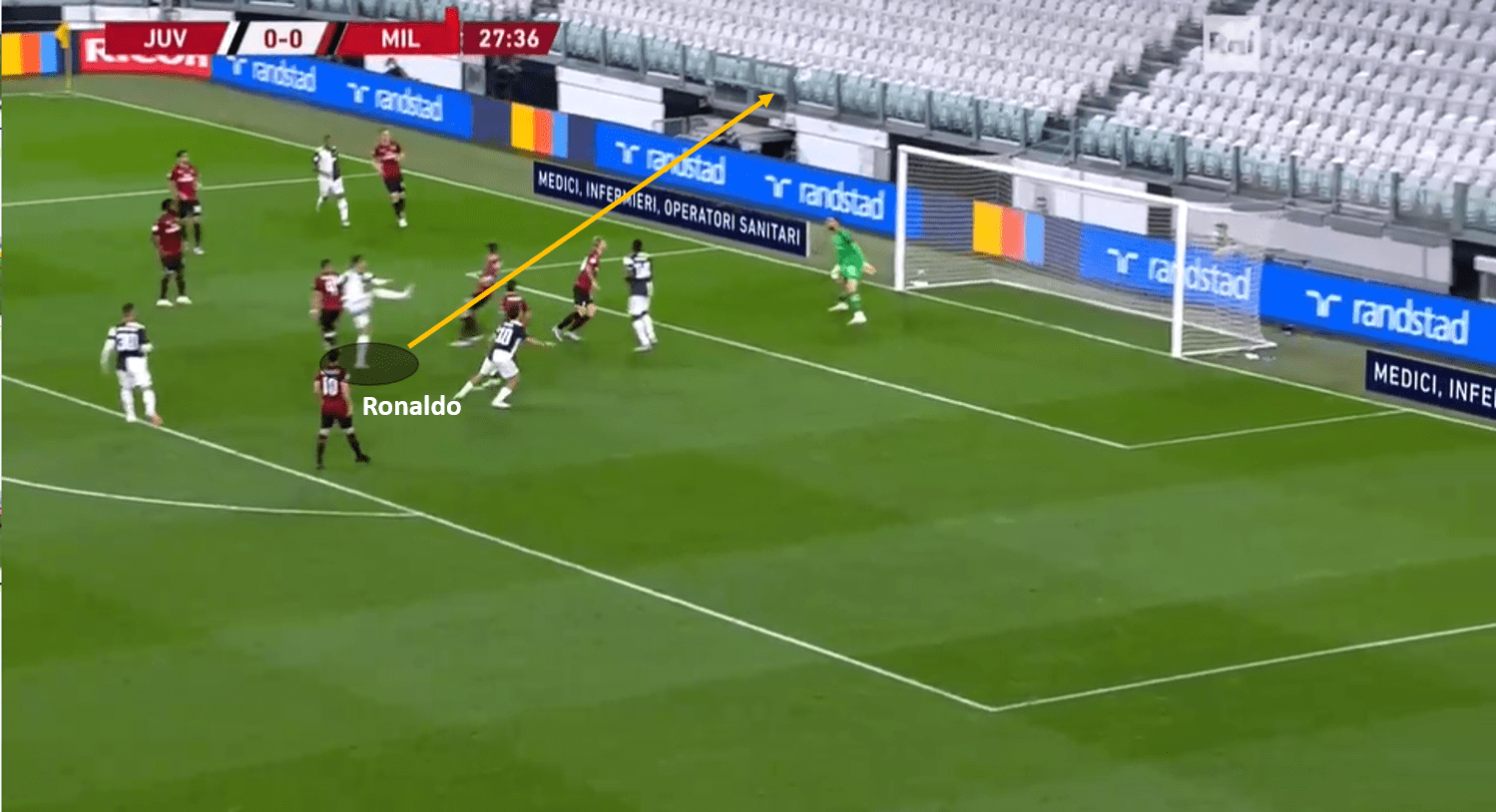
Quite rusty the finishing. Hopefully as the games go by, we see better finishing from both teams.
Conclusion
In the first game post restart, after football (and life in general!) came to an unprecedented halt back in March, Juventus and Milan played out a hard fought 0-0 draw.
Milan would feel hard done by considering they had only themselves to blame for not being able to see it through. In the first leg, it was senior players picking up unnecessary bookings and conceding a score leveling penalty in injury time. In the second leg, it was another penalty (missed) and a key player sent off for making a horror tackle. Despite all of this, Milan showed real heart in coming away with a 0-0 draw at the Allianz Stadium in the second leg. The tactical analysis shows that their solid defensive positioning was one of the reasons why Juventus weren’t able to break them down despite them being a man short.
Juventus, for their part, looked a bit rusty with the final product. The analysis shows that their defensive tactics and smart pressing flustered Milan, and forced a frustrated Rebić into making a horror tackle. While the defensive cohesion and build-up play looked as well-oiled as ever, the finished product looked rusty presumably because of the long break. Luckily for them their away goal, in the first leg before the lockdown, did enough to put the Serie A leaders into their 19th Coppa Italia finals.






Comments